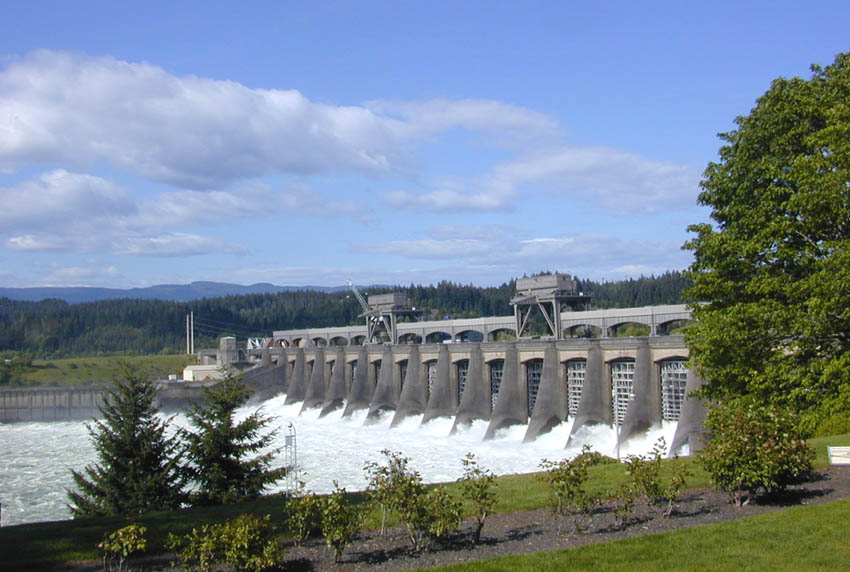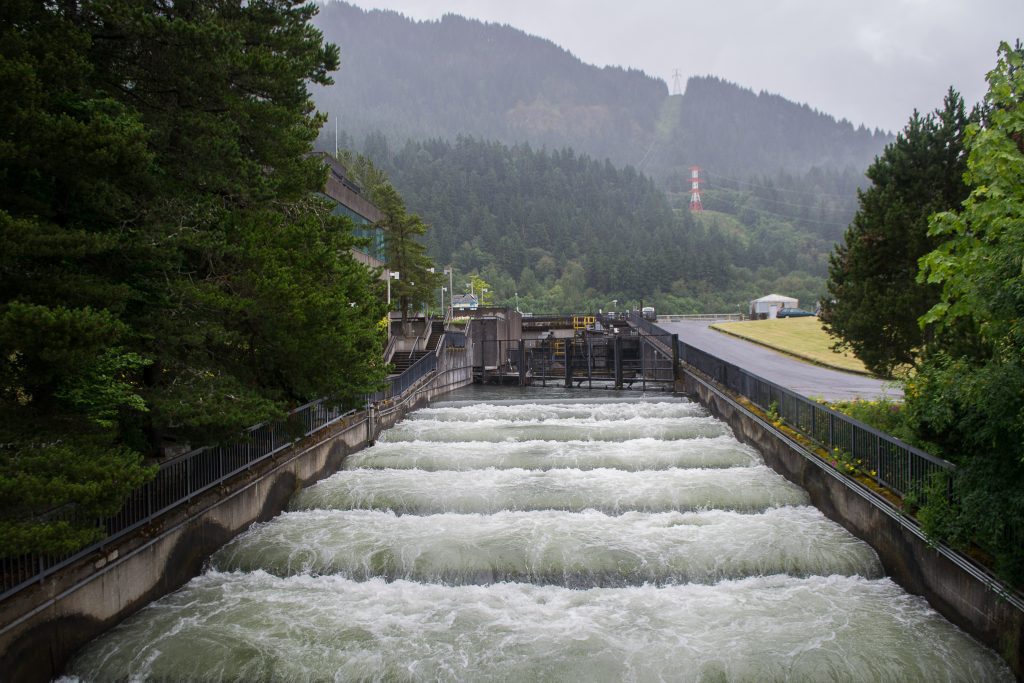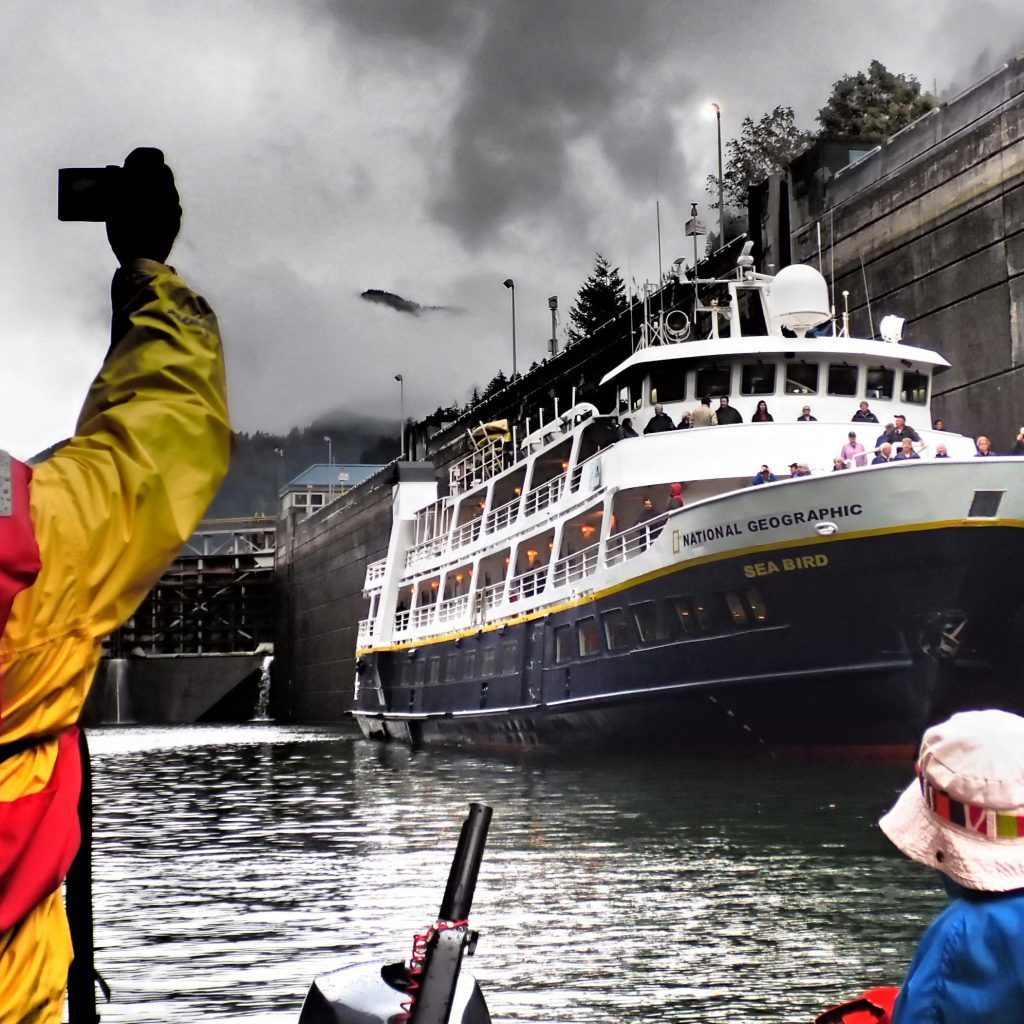
Dams changed the world. They generate almost 20% of the world’s electricity and are used to irrigate about 10% of U.S. cropland. While on your Columbia River cruise, take time to tour the Bonneville Dam. The sheer size and power of the Bonneville Dam can be humbling, and the engineering prowess that created it is remarkable.
The Story of the Bonneville Dam
 Franklin D. Roosevelt approved the Bonneville Dam project as part of his New Deal. Construction began in 1934. The dam, designed to span the Robins, Bradford and Cascades islands in the Columbia River, is about 40 miles east of Portland. The dam was constructed to help generate power, supply water for irrigation and assist with shipping. Importantly, the three-year project employed 3,000 people, and the $0.50 per hour laborer wage provided much needed income during the Great Depression.
Franklin D. Roosevelt approved the Bonneville Dam project as part of his New Deal. Construction began in 1934. The dam, designed to span the Robins, Bradford and Cascades islands in the Columbia River, is about 40 miles east of Portland. The dam was constructed to help generate power, supply water for irrigation and assist with shipping. Importantly, the three-year project employed 3,000 people, and the $0.50 per hour laborer wage provided much needed income during the Great Depression.
The Bonneville dam, the first federal lock and dam on the Columbia river, started its generators in 1938. Another powerhouse, launched in 1981, enables the Bonneville Dam to provide hydroelectricity to 900,000 homes between Portland, Oregon and Vancouver, Washington.
To facilitate and preserve fish migration, ladders were installed on each end of the dam. The fish ladders operate similarly to locks, using water to guide fish into the channel and then carry them through to the other side of the dam. To ensure the ladders were successful, fish traveling through were counted by hand several times a day during peak migration times. The counting process is still completed by hand, with web-cam technology allowing visitors to watch migrations.
The dam was named after Benjamin Louis Eulalie de Bonneville, a French-born explorer who, after graduating from West Point, took a year-long leave at age 36 to explore the Pacific Northwest. His mission? To find the best route for making western land available to Americans. Bonneville hiked part of what would become the Oregon trail and drew one of the first maps of the interior West.
For history buffs whose bucket list includes visiting all U.S. Historic Places, the Bonneville dam was added to the National Registry in 1986.
The Impressive Dimensions of the Bonneville Dam
 The dam’s spillway, the section allowing water to pass from upstream to downstream, is 1,450 feet long and has 18 steel gates to help control the flow of water. The spillway, 132 feet wide at the base and 197 feet high above bedrock, is about two-thirds as tall as the Statue of Liberty.
The dam’s spillway, the section allowing water to pass from upstream to downstream, is 1,450 feet long and has 18 steel gates to help control the flow of water. The spillway, 132 feet wide at the base and 197 feet high above bedrock, is about two-thirds as tall as the Statue of Liberty.
The navigation lock, which raises and lowers boats between different levels of water, was originally 76 feet wide and 500 feet long. Increased barge traffic on the Columbia River required a larger lock, so the Corps of Engineers expanded it in 1993 to 86 feet wide and 675 feet long – just about the length of the Golden Gate Bridge.
Original construction costs were $83 million, equivalent to $1.5 billion today. The project required 1 million cubic yards of concrete; equivalent to one foot of concrete poured throughout all of Disneyland.
Fun Activities Around the Bonneville Dam
Admission to the Visitor’s Center on Bradford Island is free. You can explore the center on your own or with a guide. Three powerhouse tours are scheduled daily. Here are other areas you may enjoy.
 Bradford Island Recreation Area has amazing spillway views of the Columbia River Gorge. You may see osprey during the summer and bald eagles during the winter.
Bradford Island Recreation Area has amazing spillway views of the Columbia River Gorge. You may see osprey during the summer and bald eagles during the winter.- Fort Cascades Site and Trail offers a 1.5-mile trail where you can learn about the fort, built in 1855, and tour historical settings home to Native Americans, the army and travelers. Follow along in the area where Lewis and Clark explored. Stops include the Blacksmith’s Shop, McNatt’s hotel, the Fort Cascades Compound, and a replica of an Indian Petroglyph.
- Geocaching is available for those seeking treasure-hunting adventure. Bonneville Dam park rangers offer eight geocaches challenging participants to use GPS-guided navigation to find the treasure. The geocaches offer a bit of education, too. Try Green Power for hydropower insights, Take Me to Lunch if you’re a sea lion lover, BIH for more about Bradford History, Bonneville Landmark for dam info, Go with the Flow to explore the fish bypass system, Duck Floats for help with water safety, and FCRPS: More Power to You to learn about the Northwestern power system.
- The Bonneville Fish Hatchery gives you the opportunity to feed rainbow trout and watch adult white sturgeon migrate.
- Navigation Lock tours are available in the summer. You can watch the lock’s operation as commercial and recreational boats pass through.
- Hamilton Island, on the Washington side of the Columbia River, has five miles of trails to hike for scenic views of the gorge and wildlife in the area.
The Bonneville Dam is a ‘must-see’ stop during your Columbia River cruise. Contact USA River Cruises to book your trip today.

